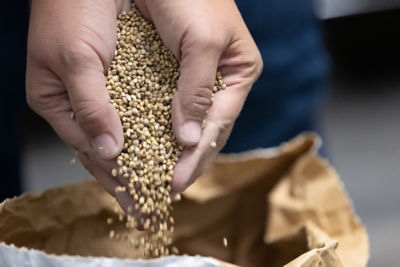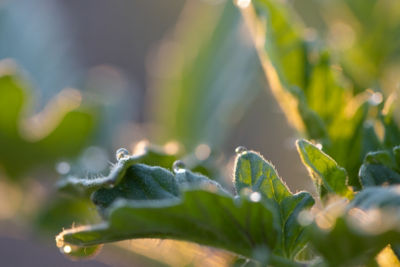Click here to download a PDF version of this Cultivation Insights article.
» The quality of water used for irrigation can substantially impact various aspects of crop growth and development.
» Water pH, alkalinity, and levels of soluble salts should be monitored to ensure water quality during the season.
» Water treatment and adjustments to nutrient levels may be needed in some situations.
The quality of water used for irrigation can substantially impact the growth and development of vegetable crops, especially in soilless, protected culture systems. Poor water quality can result in nutrient deficiencies and toxicities, salt injury to roots and foliage, increased levels of root diseases, slow growth, and, over time, plant death.1,2 There are many aspects of water quality as it relates to irrigation. The pH, alkalinity, and soluble salts level of irrigation water are particularly important for their effects on crop growth, as they impact the availability and balance of nutrients in the growth medium.
ALKALINITY AND pH
pH is a measure of the hydrogen ion (H+) concentration of water or other liquid with a range from 0 to 14. A pH value of 7.0 is neutral, with values below 7.0 considered acidic and above 7.0 considered basic or alkaline.4 The pH scale is logarithmic, meaning that the H+ concentration at 5.0 is ten times higher than the concentration at 6.0 and 100 times higher than the concentration at 7.0.3 The pH of irrigation water should be between 5.0 and 7.0.4
Alkalinity is a measure of the water’s capacity to neutralize acidity or the ability to resist a change in pH.3,4,5 The terms alkaline and alkalinity are not synonymous nor refer to the same property of water. Tests for alkalinity measure the levels of carbonates, bicarbonates, and hydroxides in water, and results are usually expressed as parts per million (ppm) of carbonate (CaCO3) equivalents. Carbonates, bicarbonates, and hydroxides are introduced into the water from materials like limestone and dolomite in aquafers.2 The alkalinity level of irrigation water should be between 0 and 100 ppm, with an optimum range of 30 to 60 ppm.2,4 The capacity to neutralize acidity can be illustrated with the following example. Water sample A has a pH of 9.3 and an alkalinity level of 71 (ppm CaCO3). Water sample B has a pH of 8.3 and an alkalinity level of 310 ppm. Lowering the pH of 100 ml of sample A to 5.0 requires the addition of 1.2 ml of sulfuric acid (0.1 N). Lowering the pH of 100 ml of sample B to 5.0 requires the addition of 6.0 ml of sulfuric acid. Even though the initial pH of sample B was lower, it took much more acid to bring the pH down to 5.0 compared to sample A. Therefore, sample B has a higher alkalinity level and a higher capacity to neutralize acidity.3
Water with a high pH does not necessarily have a high level of alkalinity, but water with a high alkalinity level will always have a pH above 7.0.4 Sometimes, the alkalinity of rainwater is too low, and bicarbonate needs to be added to the water to bring it into the optimal range.1 Measurements of both the pH and alkalinity level of irrigation water should be tested. However, the alkalinity level is usually more informative as a measure of water quality because the alkalinity level can directly affect the availability and balance of nutrients in the “soil” solution that impact plant growth and development.4
EFFECTS ON NUTRITION
Over the pH range that plants are typically exposed to, the pH level of soil, growing media, irrigation water, and fertilizer solutions do not affect plant growth directly. However, the pH level does affect the availability of nutrients, which can result in nutrient deficiency and toxicity problems (Figure 1).
Iron is usually more available at pH levels below 6.5 and becomes less available as the pH level increases above that. For most crop plants, the optimal pH range for growth is 5.5 to 6.5 (slightly acidic) because they are adapted to the levels of availability of macro and micronutrients within that range.3,5
Irrigation water with a low buffering capacity is not likely to change the pH of the soil or growing medium, regardless of the pH of the water. So, irrigation water with a high pH but low alkalinity will not neutralize the acidity of the growing medium and alter nutrient availability.4,5 Irrigation water with high alkalinity (and thus higher pH) can gradually increase the pH of the soil or growing medium over time if enough is applied. However, the amount of growing medium (based on the size of the container) can be a factor in the effect of alkaline irrigation water on the pH of the medium. Small container sizes, such as cells in plug trays, hold small volumes of media, so the effect of alkaline water will likely be higher in this situation. Irrigation water can be a source of some nutrients, such as calcium (Ca) and magnesium (Mg), and the alkalinity of the water can affect the availability of those nutrients. Water with alkalinity levels of 30 to 60 ppm can supply substantial amounts of Ca and Mg, which are not supplied in many fertilizer blends.1,4
ACIDIFYING ALKALINE WATER
Irrigation water should be tested for both pH and alkalinity. Water testing kits are available, and plant nutrition and water testing labs can test for both factors. If the alkalinity level is too high (over 60 ppm), acid can be added to the water to bring the pH down to the desired level.1,3,5 Phosphoric, nitric, and sulfuric acids are often used to acidify irrigation water. Acidifying water requires specialized equipment, including acid-compatible injectors, a flow meter, and a pH meter. Working with acids is dangerous, so caution and appropriate personal protective equipment (PPE) should always be used. Acids can also damage irrigation systems if not used properly with the correct equipment.1,3 Systems can be automated to add the amount of acid needed to lower the pH to the desired level.
Acids should be added to the water before fertilizers or pesticide solutions are added. Phosphoric and nitric acids are sources of phosphorus (P) and nitrogen (N), respectively, and the levels contributed by the addition of acid should be considered when determining fertilizer rates. Fertilizer concentrates should be diluted with acidified water before injection.2,3,4 The activity of some pesticides, such as fixed copper and lime sulfur, can also be suppressed in highly alkaline water. Acidifying water or adding buffering agents can help maintain the activity of these pesticides. A target pH of 6.0 is often recommended. Consult pesticide labels for instructions on preparation and use.2
SOLUBLE SALTS
The measurement of soluble salts, also called specific conductance, indicates the salinity of irrigation water. It is measured as the electrical conductivity of the water (ECw) in millimhos per centimeter (mmhos/cm), also referred to as milliSiemens per centimeter (mS/cm); mmhos/cm = mS/cm. High soluble salt levels can inhibit root function, resulting in nutrient deficiencies and reduced water uptake.1,2
Water with soluble salts levels of 0.5 mmhos/cm or below can be used for all irrigation purposes. Water with levels between 0.5 and 1.0 mmhos/cm should only be used in soil and substrate culture systems where leaching occurs to prevent the buildup of salinity in the root zone and not for nutrient film technique (NFT) systems. Levels between 1.0 and 1.5 may damage salt-sensitive crops, and water with salinity levels above 1.5 mmhos/cm is only marginally suitable for irrigation.1
The presence of sodium and chloride ions in water can be problematic in areas where salt is applied to roads near water sources. High concentrations of these ions can inhibit water uptake, reduce plant growth, increase root disease problems, and cause foliar chlorosis and leaf burn. High levels of sodium can also inhibit the uptake of calcium by the plant and increase the leaching of calcium and magnesium from the growing medium. This may require a change in fertilizer levels and some cultural practices.2
The reverse osmosis (RO) process can be used to lower soluble salt concentrations in irrigation water. However, it can result in other difficult-to-correct problems, such as causing deficiencies or imbalances of some micronutrients.3
The temperature of irrigation water is also an imporant factor to monitor. The optimal temperature range is 68 to 72°F (20 to 22°C). Higher temperatures can cause plant stress.6
SOURCES
1 OMAFRA. 2010. Growing greenhouse vegetables in Ontario. Ontario Ministry of Agricultural, Food and Rural Affairs. Publication 836.
2 Water quality for crop production. UMass Extension Greenhouse Crops and Floriculture Program. https://ag.umass.edu/greenhouse-floriculture/greenhouse-best-management-practices-bmp-manual/water-quality-for-crop#:~:text=In%20general%2C%20water%20 for%20irrigation,is%20confused%20with%20%22alkalinity%22.
3 Ornamental Production: treating irrigation water. Texas A&M Extension, AgriLife.
https://aggie-horticulture.tamu.edu/ornamental/greenhouse-management/treating-irrigation-water/.
4 Cox, D. 1995. Water quality: pH and Alkalinity. UMass Extension Greenhouse Crops and Floriculture Program. University of Massachusetts Amherst.
5 Fernandez, T. 2018. Water alkalinity and pH: what they mean in regard to water quality. Michigan State University Extension.
https://www.canr.msu.edu/news/water_alkalinity_and_ph_what_they_mean_in_regards_to_ water_quality.
6 Research uncovers a new approach to cooling greenhouse irrigation water. HortiDaily.
https://www.hortidaily.com/article/9513240/research-uncovers-a-new-approach-to-cooling-greenhouse-irrigation-water/.
Websites verified 5/8/2023
Bayer, Bayer Cross, De Ruiter & Greenhouse Leaf Design® and De Ruiter® are registered trademarks of Bayer Group. ©2023 Bayer Group. All rights reserved.
ADDITIONAL INFORMATION
For additional agronomic information, please contact your local seed representative.
Performance may vary, from location to location and from year to year, as local growing, soil and weather conditions may vary. Growers should evaluate data from multiple locations and years whenever possible and should consider the impacts of these conditions on the grower’s fields. The recommendations in this article are based upon information obtained from the cited sources and should be used as a quick reference for information about greenhouse cucumber production. The content of this article should not be substituted for the professional opinion of a producer, grower, agronomist, pathologist and similar professional dealing with this specific crop.
BAYER GROUP DOES NOT WARRANT THE ACCURACY OF ANY INFORMATION OR TECHNICAL ADVICE PROVIDED HEREIN AND DISCLAIMS ALL LIABILITY FOR ANY CLAIM INVOLVING SUCH INFORMATION OR ADVICE.
5021_232880 Published 05/18/2023



